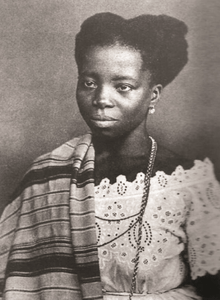Tia Ciata
Tia Ciata, born Hilária Batista de Almeida (1854-1924) was a cook, mãe-de-santo of Candomblé, and an influential figure in the development of samba.[1][2] She was born in Santo Amaro, Bahia, and initiated in Candomblé in Salvador by Bangboshe Obitikô (Rodolfo Martins de Andrade). She was a devotee of deity Oshun and became the iyakekerê, or second most important leader, in the terreiro of João Alabá in Rio de Janeiro. "Ciata", the name by which she is now known, is a variant on the Arabic name Aycha; it was a common feminine name among the Muslim community from Portuguese Guinea that formerly resided in Rio de Janeiro.[1]
Tia Ciata | |
|---|---|
 Tia Ciata, c.1900 | |
| Born | Hilária Batista de Almeida 1854 |
| Died | 1924 |
| Nationality | Brazilian |
| Occupation | Cook, mãe-de-santo of Candomblé |
| Known for | Early figure in samba |
| Spouse(s) | João Batista da Silva |
Tia Ciata arrived in Rio de Janeiro in 1876 at the age of 22 and worked as a vendor at a food stall.[2] She lived on Rua Visconde de Itauna in the neighborhood of Praça Onze (now Cidade Nova), an area which became known as "Pequena África", or Little Africa. It was here that Tia Ciata became one of the main progenitors of Afro-Brazilian culture of early favelas of Rio de Janeiro. Samba musicians, composers, and dancers regularly gathered in her home; her residence may be one of the birthplaces of the genre.[1][2] The first samba recording, Pelo Telefone, a composition by Donga (Ernesto Joaquim Maria dos Santos) and Mauro de Almeida, was recorded in the residence. Like Tia Citata, the vocalist of Pelo Telefone was from Santo Amaro, Bahia. She married João Batista da Silva, and had fourteen children. The couple became noted figures in Pequena África of Rio, and Tia Ciata was honored annually at the Rio Carnival until her death in Rio de Janeiro in 1924.[1]
References
- Lopes, Nei (2015). Dicionário escolar afro-brasileiro. São Paulo: Selo Negro. p. 162. ISBN 9788587478955.
- Penglase, Ben (2016). "Tia Ciata". Africana: The Encyclopedia of the African and African American Experience (2nd ed.). Oxford African American Studies Center.